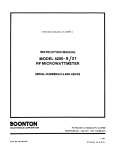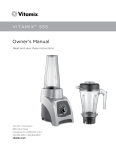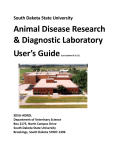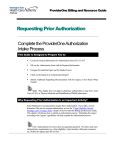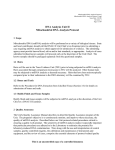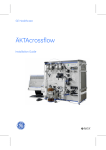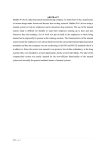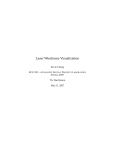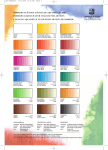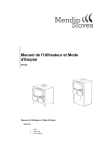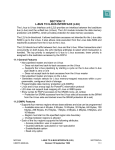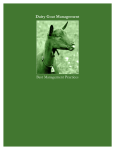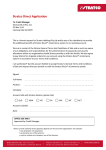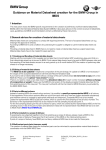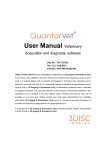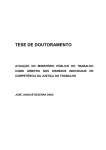Download View a PDF of this issue - Wisconsin Center for Dairy Research
Transcript
Wisconsin Center for Dairy Research Dairy Pipeline A Technical Resource for Dairy Manufacturers Fall 1999, Volume 11 Number 4 Mechanics of Membrane Processes, Part 1 By Karen Smith, Ph.D., CDR’s Whey Applications Program Membrane technology is used throughout the food industry, particularly in the dairy segment. According to the “Ultrafiltration and Microfiltration Handbook,” dairy applications account for the majority of installed membrane capacity in the food industry. Although membrane technology continues to evolve and improve, the basic concepts emerged in the1700’s. Abbe Nollet was to first to observe osmosis—when water diffuses from a dilute solution to a more concentrated one through a semi-permeable membrane. Back in those days natural substances like pig bladders and onion skins were used as semi-permeable membranes, or membranes that let solvents through while holding solids back. In the 1800’s, the earliest artificial membranes were developed— from nitrocellulose. Then, leading into the early 1900’s, the field of physics expanded with thermodynamic theories that influenced membrane development. By the 1940’s and 50’s membranes were commonly used to remove microorganisms, for example by filtering drinking water. At the same time, scientists began to try reverse osmosis, to remove salt from seawater. By the 80’s, ceramic membranes were used commercially in everything from nuclear power reactors to dairy plants in France. Type of filter In the past, filtration processes have relied on depth filters, a type of filter made with fibers or beads in a mesh-like structure, Figure 1. Particles in the feed solution become trapped or adsorbed within the filter network, eventually clogging the filter and requiring replacement. In contrast, membranes are screen filters with pores—the pores are more rigid and uniform, Figure 2. Pore size and shape determines the passage of particles, allowing a more narrowly defined size than the mesh openings in a depth filter. Components that don’t fit through the pores in a screen filter remain on the membrane surface. Since they don’t become trapped within the membrane structure internal fouling is less and you can reuse the membrane. Figure 1 What's Inside: Mechanics of Membrane Processes .................................... 1 Evaluating Sensory Quality of Cheese: —Beyond Good Versus Bad ........................................................................... 5 News from CDR ................................................................... 8 Curd Clinic ......................................................................... 10 Calendar ................................................................ Back page Depth Filter continued on page 2 University of Wisconsin—Extension College of Agricultural and Life Sciences Figure 2. Table 1. Reverse osmosis, RO ♦ Retains molecules in ionic size range ♦ Pore size at resolution of scanning electron microscope ♦ Operating pressure: 200 to 1,200 psig ♦ Theory: ability of compound to mimic tetrahedral structure of water determines ability to permeate (for example: methanol, urea) Nanofiltration, NF Screen Filter ♦ ♦ ♦ ♦ Permeate: monovalent ions Retentate: divalents ions, sugars, proteins and fat Operating pressure: 150 to 300 psig Theory: diffusion and flow through pores, controlled by mass transfer. Ultrafiltration, UF Figure 3. ♦ ♦ ♦ ♦ Permeate: minerals, NPN and sugars Retentate: protein and fats Operating pressure: 30 to 150 psig Theory: shape, charge, flexibility, molecular weight determine ability to cross membrane Microfiltration, MF ♦ ♦ ♦ ♦ Permeate: minerals, sugars, small proteins Retentate: fat and large proteins Operating pressure: 20 to 100 psig Theory: size determines ability to cross membrane Filtration flow Perpendicular filter flow 2 In traditional filtration, the entire stream passes through the filtering medium—the incoming stream is perpendicular and the filter retains trapped solids. (Figure 3.) RO, UF, and MF use a cross-flow filtration, (Figure 4.) where the feed stream passes parallel to the filter or membrane. At any time, only some of the water and particles will cross the membrane, which does limit the applications. For example, it’s difficult to separate all the protein from lactose with 100% efficiency since all the solution doesn’t cross the membrane. Compared to the traditional method, cross flow streams are self cleaning because the fouling material is continually swept along and away from the membrane surface, allowing longer operating times. Figure 4. Cross flow filtration Type of process Membrane structures These days, the types of pressure driven separation processes are defined by the pore size of the semi-permeable membrane and the amount of pressure, although the classifications are still somewhat subjective and you’ll find some overlap. Table 1. describes the most common classes of the separation process. In general, RO, or reverse osmosis, uses the highest pressures and membranes that only allow the smallest particles through, while MF, or microfiltration, is associated with lower pressure and larger pore sizes. What can we make membranes out of? It really varies, you can make membranes out of inorganic materials, like ceramics or stainless steel, and a range of organic materials like nylon, polypropylene, cellulose, etc. Of course, different materials are useful for different applications. In the dairy industry it is important to use membrane materials that aren’t toxic, that are heat and pH resistant, and that are stable through chemical cleaning, You might also prefer a low cost, high flux model. The actual pores aren’t visible in RO membranes, instead it’s the structure of the water within the membrane that is important. Think of the membrane as a water swollen gel, and it is water itself that moves through the membrane, based on the ability of several water molecules to form a tetrahedral, or ice-like, structure via hydrogen bonding. Only molecules that fit into this tetrahedral structure can cross the RO membrane. One molecule that does cross is lactic acid, because it is a small molecule that binds to hydrogen. Both UF and MF separate compounds based on size, fundamentally acting as a sieve that rejects molecules too large to fit through the pores while allowing smaller molecules to enter the permeate stream. The pressure is the driving force. Speaking of flux, it’s another term you need to know when discussing filtration. Flux is a measurement that describes the amount of permeate produced in a given time unit, for a given membrane area in a specific time period. It’s important because flux affects the economics of the system and is an indication of membrane fouling and cleaning possibilities. The lower the flux, the greater the membrane area required to process the same amount of product in a given time. Pressure, feed velocity, temperature, viscosity (or thickness) and turbulence all influence flux. Now that you have mastered the basics, in the next Dairy Pipeline I’ll be covering membrane configurations and the role of membrane processing in the dairy industry. Of course, system parameters like membrane composition and operating conditions will have a major influence on operation. For example, temperature, pressure, and concentration all affect permeability. 3 Annual Wisconsin Dairy Field Reps Conference February 1-2, 2000 Crown Plaza Hotel - Madison East Tuesday, Feb. 1 Morning Quality Milk Production in Wisconsin Moderator – Larry Tuschen UW Milk Quality Systems Pamela Ruegg, DVM Research Update on Milk Quality Bill Wendorff Bulk Tank Culture Interpretations Nigel Cook, DVSC UF/RO of Raw Milk Robert Fassbender Afternoon Panel Discussion “Working Together for Milk Quality” Moderator – Jim Glaeser Jim Wickert, Rating officer Phil Carley, Inspector David Rhoda, DVM, Veterinarian Jeff Montsma, Field Rep Ken Bolton, County Dairy Agent Milk Pricing Issues Moderator – Denny Zimmer True Protein Impact on Milk Pricing Bob Cropp Dairy Industry’s Investment with Check-off Programs Will Dahl Business Meeting Social Conference 4 Wednesday, Feb. 2 Morning Critical Regulatory Issues for Quality Milk Moderator – Bob Bradley Environmental Issues on Dairy Farms Jim Arts Johne’s Disease, Current Issues Libby Balzer, DVM Update on Milk Surveys Randy Daggs Current Concerns from WDATCP Tom Leitzke Interested? Contact Bill Wendorff at (608) 263-2015 Evaluating Sensory Quality of Cheese: Beyond Good Versus Bad by MaryAnne Drake, asst. professor, Mississippi State University and the Southeast Dairy Foods Research Center Sensory quality is a critical issue in cheese production and marketing because it encompasses all aspects of cheese—from flavor and aroma to functionality and texture. Whether your cheese tops a pizza, fills an enchilada, or graces a table in a five star restaurant, sensory quality is evaluated at some level. Yes, we do have mechanical tests that mimic or predict various sensory measurements, but sensory testing remains a fundamental and irreplaceable tool for three reasons. No equipment required Sensory testing does not require the up-front purchase of an expensive piece of machinery. Sound sensory testing can be conducted by outside suppliers or contractors or by a few individuals who also perform other jobs at the plant. Versatility There are numerous sensory tests, depending on the specific objectives you need. Sensory tests can be simple or complex—you can design them to measure aroma, texture, or flavor. Perception by human subjects Ultimately, the consumer judges sensory quality. Thus, human evaluation of sensory properties is perhaps the best predictor of fellow human perceptions. When used appropriately, sensory analysis is an extremely powerful tool. Traditional tools The dairy industry has developed two traditional tools for evaluating flavor and texture quality—cheese grading and ADSA scorecard judging. Both techniques involve one or more expert evaluators who generate an overall quality score or grade for a cheese, while also noting specific defects. These tools have been used for more than 50 years and both industry and academia continue to use them widely to provide a rapid, relatively simple way to assess overall sensory quality. While sound and useful tools, these techniques provide an expert opinion of quality. However, consumer opinion and expert opinion of cheese quality may not match. Further, these techniques only list the defects present. Individual defect intensities are not quantified and positive attributes are neither identified nor quantified. It isn’t possible to use statistical analysis with grading. Also, it isn’t appropriate to use statistical analysis for quality scores from scorecard judging because the scales are not linear. However, you can use additional analytical sensory tests to augment these traditional tools and add a new dimension to sensory testing. Analytical sensory tools Mainstream sensory analysis involves a versatile set of tools that fall into two categories: discriminative tests and analytical tests. Discriminative tests are difference tests. They measure general differences in products and include the following: triangle tests, duo-trio tests, paired preference and ranking tests. These tests are simple to set-up, require little or no training of personnel and are easy to interpret. Qualifiable information is provided, essentially you are asking: Does a difference exist? Quantifiable information regarding the degree of difference is not provided—you haven’t answered how much? Analytical sensory tests, also called descriptive analysis, provide qualifiable and quantifiable information. No judgement of “good” or “bad” is made. Attributes present are identified and the intensity quantified. You can analyze the data by statistical methods, directly correlating them to instrumental measurements. It is this qualifiable (what’s there) and quantifiable (how much is there) information that makes descriptive analysis an invaluable tool in product development, research, quality control, and consumer studies. Evaluating Flavor Both aroma and taste make up flavor—a critical component in cheese application and marketing. Extensive research has been conducted with instrumental analysis of flavor components, but, for now, sensory evaluation remains the best way to assess cheese flavor. Developing a standard Cheddar flavor language Although descriptive sensory analysis is an extremely useful tool in product development and research, it can be even more useful. Right now, standard descriptive language for evaluating cheese doesn’t exist. Instead, researchers in continued on page 6 5 Difference Tests These are brief descriptions of some simple sensory difference tests, often used to determine product differences, or to select and train panelists to discern differences. Triangle test Each participant has three coded samples. One is different and two are identical. Ask them to pick out the different sample. industry and academia have used their own descriptors. Terms used by sensory panels at different sites generally do not have published definitions or references, making communication difficult and replication of test results very difficult, if not impossible. Recently, Dairy Management Inc. funded a project to develop a standard descriptive language for Cheddar cheese, with definitions and references for individual terms. In the past, researchers have proposed a universal language for describing Cheddar cheese or cheese in general. However, these studies used very small sample sets (20 to 30 cheeses) and the language was not developed by cheese experts. In the present study, a collection of 250 Cheddar cheeses was screened to generate 70 representative Cheddar cheeses. The cheeses varied by age, and they came from different geographical regions. A group of cheese experts (n=15) from industry, government, and academia tasted the cheeses and generated a basic language of 23 words to describe cheese flavor. Duo-trio tests Then, a descriptive panel began to “fine tune” the language and identify standard Each participant receives a reference references for the terms. These references will allow anyone to easily train a sample, and two coded samples. Ask descriptive panel—a panel that evaluates cheeses using the same language as them to choose the coded sample that other panels. matches the reference sample. Using descriptive analysis The following tests are examples of attribute difference tests, you can use Two 3-month-old Cheddar blocks Cheese grade results were graded by a USDA cheese them to determine if two or more grader and evaluated by descriptive samples differ with respect to a Cheese 1 A sl bitter, sl flat analysis with the Cheddar language. Cheese 2 defined attribute. For example, A sl bitter, sl flat “Which one is sweeter?” Notice that the cheeses received the same grade. However, the Paired preference graph of the descriptive A common attribute difference test, analysis illustrates used to show which sample has more that these two of the attribute you are testing. cheeses have vastly different flavor Ranking profiles. The differences in This is one method which you can flavor profile use to rank samples according to between these intensity of one attribute. two cheeses could be very References important for Sensory Evaluation Techniques, M. product developMeilgaard, D. Sc., G. Civille,B. S., B.T. ment or end Carr, M.S. product applicaCDR Press, Inc. 1991 tion. Using descriptive analysis with the Cheddar language Descriptive analysis with Cheddar language (not all terms are listed) 6 allows us to “profile” the flavor of the cheeses, illustrating the differences in flavor profiles. We all know that Americans are consuming more cheese and a more types of cheese than ever before. To develop new cheese types, or sell the right cheese to the right market, it’s essential to determine consumer preference. In 1997, Dairy Management Inc. conducted a market segmentation study of cheese consumption. From this study, we know the market segments of cheese consumption and how the different segments consume cheese. Using this information, we could go to any region in the U.S. and characterize the cheese consumers in that area. We know that regional flavor preferences exist, but we don’t have reliable valid substantial information on the flavors that particular market segments prefer in cheese. By combining market segmentation data with descriptive sensory analysis with a universal cheese language, we could determine those preferred flavors. Applying this information would then allow more specific “niche” marketing. On the same note, flavor profiling by descriptive analysis can also help to match the right cheese with the right consumer or the right buyer for the right application. Sensory analysis is an extremely powerful tool with multiple dimensions and many applications in the cheese industry. Using analytical descriptive sensory tools to identify and quantitate all flavors in cheese can provide critical information for product development, research, quality control, and marketing. Acknowledgements This is a condensed version of a talk presented at the 1999 Marschall Cheese Seminar in Santa Clara, California, reprinted with permission. Thanks is extended to Dairy Management, Inc. for funding parts of the research presented. Thanks to Mark Smith, Steve Wright and Rhodia, Inc. for their support of the Cheddar flavor language. Sensory language—FAQ’s Q. Is sensory language proprietary? A. NO! This is a common question among people new to sensory analysis and a question that has been previously posed—and debated in arbitration—in other commodity areas. You can use a different word for a particular term or create a foreign language to evaluate your product, but anyone who knows descriptive analysis would be able to taste your product and identify the flavors. The flavor of your cheese is not a secret to your competitors—how you created or developed that flavor is. Q. Can a standard language be developed for cheese texture or for other types of cheese? A. Yes! Once we finish Cheddar flavor language, we will begin to apply it to other cheese types. We are also developing standard descriptive language for texture. Q. Does descriptive sensory analysis with the standard Cheddar language take the place of cheese grading or ADSA judging? A. No! Descriptive analysis with the standard Cheddar language will give the industry another analytical tool for research, product development, and marketing. As discussed earlier, grading and judging are useful and have unique applications. Descriptive analysis with the Cheddar language provides an additional sensory tool to identify and quantify specific flavors in cheese without reference to “good” or “bad”. Q. What can the Cheddar language do that grading or ADSA judging does not do? A. The Cheddar language is a descriptive analysis tool for flavor profiling. You can use it to identify and quantify all the flavors in your cheese. You can also apply statistical analysis to results, which allow you to analyze the data and identify how sensory descriptors relate to chemical compounds, instrumental analyses, and consumer preference. With grading and judging, only defects are identified and statistical analysis cannot be conducted. 7 News from CDR All the folks who work at CDR have been getting a head start on seasonal indulgences—we’ve been tasting shortbread, brownies, cakes and cookies made in the Applications Lab. It’s all due to Kathy Nelson, recently hired Research Specialist, who has been testing milkfat fraction formulations. When she is done with her analysis, the products are ours to sample, and they have been worth sampling! Kathy earned a Masters degree in Food Science at UW-Madison in 1989 and moved to Minneapolis to work at Pillsbury as a product scientist in the Baked Goods section. She left the corporate world take classes at the Culinary Institute in New York before opening her own catering business. Kathy notes that she really enjoyed the cooking but her business skills didn’t match up to her cooking prowess. She enjoys working at CDR, a setting that provides an ideal combination of science and culinary skill. Aren’t you glad you listened to your Mom when she said, “Drink your milk”? Mom was right. Dairy ingredients provide essential nutrients and offer unique functional attributes to foods. The article “Dairy Ingredients for Health” written by Kimberlee J. Burrington appears as the cover story in Food Product Design, October 1999 issue. The article explores the components and derivatives of milk and tells why it does a body good. To read the article in it’s entirety, check out the editorial library at www.foodproductdesign.com Wisconsin Process Cheese Seminar February 22-23, 2000 Babcock Hall Madison, Wisconsin The Wisconsin Process Cheese Short Course is a two-day hands-on short course designed to cover the basics of formulation and manufacture of pasteurized process and cold-pack cheese products. This course will begin with the basic theories and chemistry of process cheese manufacture and will include the practical aspects of process cheese making. The hands-on laboratory sessions will cover the manufacture of various process cheese products. For more information contact Jim Path at (608)262-2253 or Bill Wendorff (608) 263-2015. Sponsored by: University of Wisconsin-Madison Center for Dairy Research, Department of Food Science and Cooperative Extension Service, College of Agricultural & Life Sciences 8 Economic Analysis of Cheese Yield In 1992 researchers at the Wisconsin Center for Dairy Research developed a computer program, CHYIELD© that cheese makers could use to analyze alternative milk standardization procedures. CHYIELD© worked well, but after a few years, it was clear that we needed to improve it. For example, there was no internal check of the protein or solids contents of standardized cheese milk. This is particularly important when you add high protein dry products, such as NFDM, as your standardizing agent. Also, CHYIELD© paid little attention to obtaining a detailed mass balance of supply versus utilization of the components of the cheese milk. In addition, the ability to produce alternative types of by-products was limited. A major limitation of CHYIELD© was that it was a DOS-based program and unable to use many features of Windows© programs. In 1998, we decided to revamp CHYIELD© to overcome the shortcomings listed above. We call our new program EACY© (Economic Analysis of Cheese Yield). All the features in the original program are incorporated within EACY© which is a native Windows program that runs under Windows 95, Windows 98 and Windows NT. We have also added many new features. For example, EACY© allows the user to limit the maximum solids content of the standardized cheese milk. If this limit is reached, the program automatically adds water to the standardization agent to reduce the solids content. The user can also specify the total solids percentage of the standard agent when the total solids limit is in effect. Again, water is added so the standardization agent does not have excessive solids. The profile of the modified standardization agent is displayed automatically by the program. Current status of EACY© We are developing an on-line help system for EACY© as well as a user’s manual. We are also beta testing the software with the help of volunteer Wisconsin cheese manufacturers. We need more volunteer firms to improve the quality of EACY©. If your firm would like to obtain a beta version of EACY© in exchange for providing feedback, please contact Brian Gould using the email address below. After participating in this beta testing, your firm will receive a free copy of the final version of EACY© as well as free upgrades for a year. If you are interested contact: Dr. Brian W. Gould Wisconsin Center for Dairy Research (608) 263-3212 [email protected] 9 Curd Clinic Curd clinic doctor for this issue is John Lucey, assistant professor of Food Science, UW-Madison Questions for the Curd Clinic? Write to: CDR, UW Dairy Pipeline 1605 Linden Dr. Madison, WI 53706 FAX: 608/262-1578 e-mail: [email protected] Factors that affect “watering off’ Structure: low pH excessive proteolysis high MNFS, high fat Temperature: high storage temperatures Time: salt gradients after brining proteolysis Q. I’ve noticed that some packaged cheeses seem to “leak” fluid into the package. What causes this problem and how can I prevent it? A. Although little information has been published about this problem, some cheeses do indeed exude whey (“watering-off ”) after manufacture. In general, watering-off is more commonly observed in low pH, or high acid cheeses such as Cheshire, Feta and young Blue. This a physico-chemical problem, generally related to the inability of the cheese structure to retain all moisture. Structure, temperature and time all contribute to the problem of “free water” (technically it’s “free serum”). Cheese is a casein-based matrix made from aggregated casein particles which fuse to form a firm network structure. This matrix is responsible for the texture and water holding ability of cheese. Mineral and salt content, pH, moisture and levels of proteolysis all influence the structural matrix. Cheese needs an appropriate structure to retain all the moisture during storage since much of that moisture is physically retained within the cheese matrix. If the pH is too low, or there is excessive proteolysis, then the cheese can become crumbly. Now it is physically less able to retain moisture. In cheese with a high fat content or a high moisture content, (high moisture in the nonfat solids, or MNFS) there is more “stress” on the cheese which influences its ability to retain moisture and, possibly, proteolysis. Storage temperature also influences watering off. At high temperatures, cheese becomes softer and curd strands/junctions may decrease in size and strength. This is caused by strengthening of internal hydrophobic interactions within the casein particles. You can easily see this effect in some yogurts, which can water off when left out at room temperature—return it to the refrigerator to chill and the water can be absorbed. Time is another factor. Long storage times affect susceptible cheeses because they allow the opportunity for breakdown of the structure, once again impairing the ability to retain moisture. Additionally, the larger the cheese block, the more time that is required for salt and moisture equilibrium. The cheese may continue to lose moisture (to the surface) after manufacture. If the cheese is already wrapped, then this moisture accumulates inside the package. Late acid development (in the block) might also be involved in this defect. Many traditional brine salted cheeses lose moisture by evaporation during storage. If wax or plasticoat is used, it is applied after the cheese surface has (partially) dried out. However, rindless cheeses are increasing in popularity. Replacing the rind with packaging material means that surface moisture might accumulate inside the packaging material. 10 You may need to make these cheeses with a lower moisture content than rindless cheese, or you may need to allow enough time to lose any “free” moisture before you package the cheese. Parmesan provides a good example. If it is dry salted and shelf-dried properly, then you won’t see any watering off. However, vacuum packed Parmesan can cause some trouble. Try letting it dry longer before you package it, check the humidity in your ripening room, and consider better whey drainage during manufacture. Blue cheese, a high salt, high moisture cheese, begins with a high acid curd that may have more moisture than the cheese can absorb. The cheese surface usually dries out in the storage room. However, when you package the cheese you may see some watering off, especially if the moisture is too high and you haven’t allowed enough time for drying. Panela is a high acid, salty Hispanic cheese that easily waters off at room temperature. However, panela is most often used as a cooking cheese. The slightly sweet flavor of lactose on the cheese surface is an expected flavor that also browns when the cheese is fried—all part of the panela experience! Watering off can be problem anytime packaged cheese is stored inappropriately at a temperature that is too high. If you can rule that out as the cause, then you need to look at moisture retention in your cheese. For an indepth discussion of the role of casein, review the Spring 99 issue of the Dairy Pipeline. 11 Calendar Feb. 1-2 Wisconsin Dairy Field Reps Conference. Madison, WI. Call Bill Wendorff at (608) 263-2015. Feb. 22-23 Wisconsin Process Cheese Short Course. Madison, WI. Call Jim Path at (608) 262-2253 or Bill Wendorff at (608) 263-2015 for more details. Mar. 14 Wisconsin CIP Workshop, Madison, WI. Call Bill Wendorff at (608) 263-2015. Mar. 15 Dairy HACCP Workshop, Madison, WI. Call Marianne Smukowski at (608) 265-6346. Mar. 27-31 Wisconsin Cheese Technology Short Course, Madison, WI Call Bill Wendorff at (608) 263-2015. Apr. 5 WDPA Butter & Cheese Evaluation Clinic, Wis. Dells, WI. For information, call Brad Legreid at (608) 836-3334. Apr. 11-12 Master Starter Culture Seminar, Madison, WI. Call Jim Path at (608) 262-2253. Apr. 11-14 Basic Cheesemaker’s License Short Course, River Falls, WI. Call Ranee May for further info at (715) 425-3150. Apr. 26-27 International Cheese Technology Expo, Madison, WI. For information, call Judy Keller at (608) 255-2027. May 2-3 Whey and Whey Utilization Short Course, Madison, WI. Call Bill Wendorff at (608) 263-2015. May 17-18 Applied Dairy Chemistry Short Course, Madison, WI. Call Bill Wendorff at (608) 263-2015. June 6-7 Wisconsin Cheese Grading Short Course, Madison, WI. Call Bill Wendorff at (608) 263-2015. Wisconsin Center for Dairy Research CDR University of Wisconsin-Madison 1605 Linden Drive Madison, Wisconsin 53706-1565 ADDRESS SERVICE REQUESTED CDR Dairy Pipeline The Dairy Pipeline Center for Dairy Research 1605 Linden Dr. Madison, WI 53706 phone: 608/262-5970 fax: 608/262-1578 Karen Paulus, Editor Technical Reviewers: Mark Johnson, CDR Norm Olson, Dept. of Food Science Jim Path, CDR Marianne Smukowski, CDR Tom Szalkucki, CDR Karen Smith, CDR Bill Wendorff, Dept. of Food Science The Dairy Pipeline is published by the Center for Dairy Research and funded by the Wisconsin Milk Marketing Board. To subscribe to the Pipeline simply phone, fax, or e-mail your request to CDR. (Form on page 11) We welcome your questions and comments. Send them to: Karen Paulus, Editor e-mail: [email protected] phone: 608/262-8015 You can also find the Dairy Pipeline on our website: www.cdr.wisc.edu Nonprofit Org. U.S. Postage PAID Madison, WI Permit No. 658













